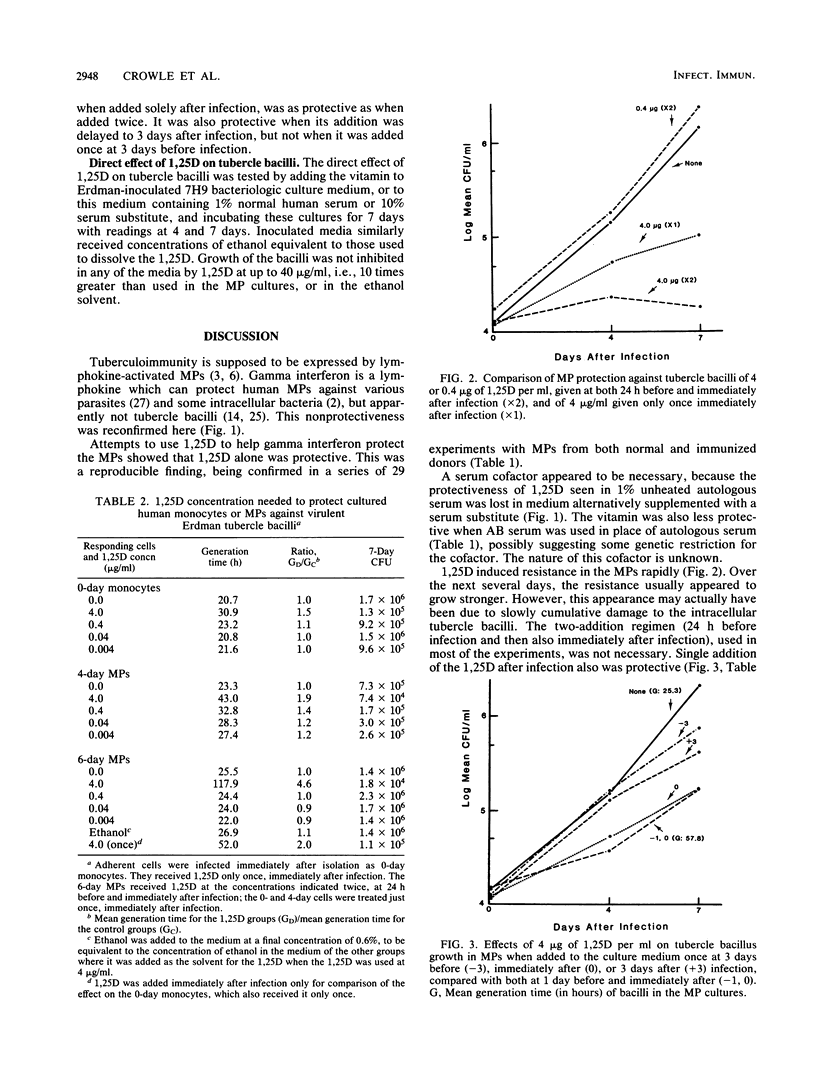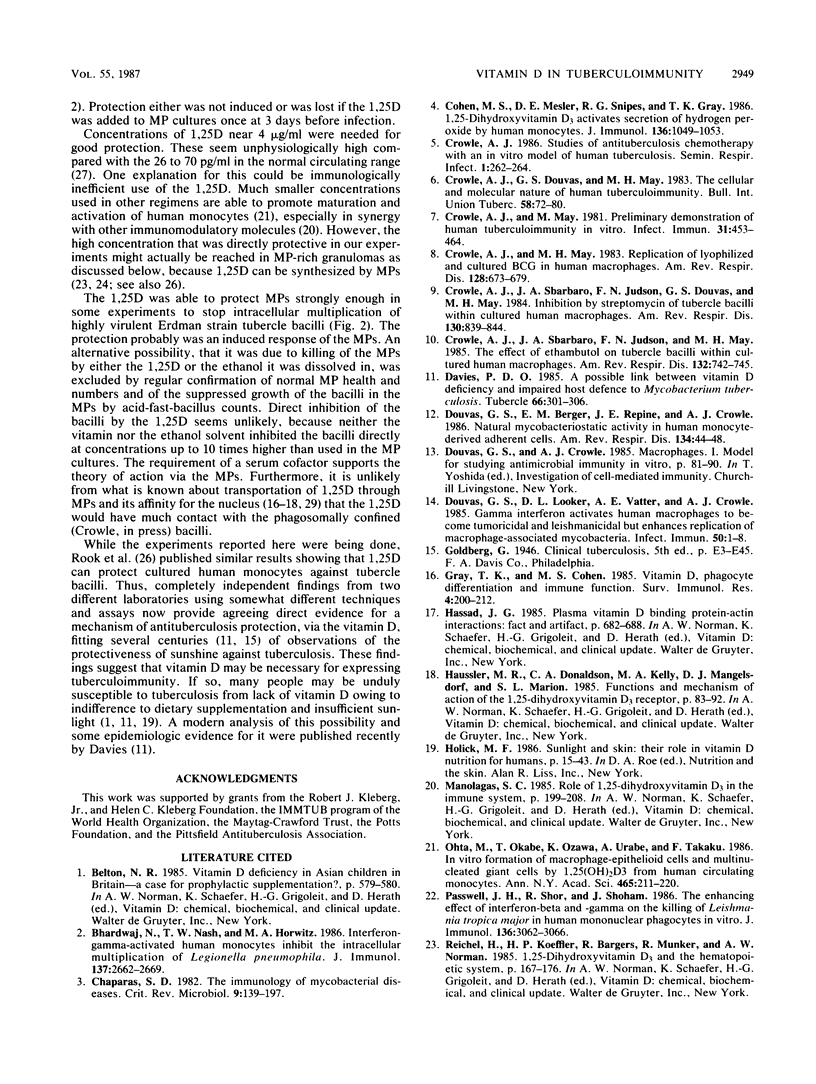Abstract
Historically, sunlight has seemed to fortify antituberculosis resistance. Evidence is presented here suggesting a role for vitamin D in this effect. The active metabolite of this photosynthesized vitamin, 1,25-dihydroxy-vitamin D3 (1,25D), promotes maturation and activation of human monocytes and macrophages (MPs). Therefore, it was tested for ability to protect MPs against virulent tubercle bacilli. MPs were derived by 7-day culture from blood monocytes, infected with the bacilli, and exposed to 1,25D in several regimens. Their inhibition of bacilli was measured by lysing samples of the cultures at 0, 4, and 7 days after infection and making bacillary CFU counts from serial dilutions of the lysates. 1,25D enabled MPs to slow or stop bacillary replication. Autologous serum supported the 1,25D-induced protection because the vitamin was not effective in medium supplemented with a serum substitute and was less effective in a heterologous AB serum than in autologous serum. The protection developed rapidly and could be induced even when 1,25D was added 3 days after infection. A concentration on the order of 4 micrograms/ml was needed for protection by the regimens used in these experiments. That is considerably higher than normal circulating concentrations of 1,25D but could be reached in infectious granulomas, because MPs can make 1,25D from precursor 25-hydroxyvitamin D3. The precursor circulates at levels 10(3) higher than those of 1,25D and is directly influenced by dietary intake or photosynthetic production of vitamin D. These results identify 1,25D as an immunomodulator which can reproducibly activate human MPs to express tuberculoimmunity. They connect vitamin D, sunlight, and tuberculoimmunity and suggest that vitamin D should be considered a vital factor in the practical control of tuberculosis.
Full text
PDF





Selected References
These references are in PubMed. This may not be the complete list of references from this article.
- Bhardwaj N., Nash T. W., Horwitz M. A. Interferon-gamma-activated human monocytes inhibit the intracellular multiplication of Legionella pneumophila. J Immunol. 1986 Oct 15;137(8):2662–2669. [PubMed] [Google Scholar]
- Chaparas S. D. The immunology of mycobacterial infections. Crit Rev Microbiol. 1982;9(2):139–197. doi: 10.3109/10408418209104488. [DOI] [PubMed] [Google Scholar]
- Cohen M. S., Mesler D. E., Snipes R. G., Gray T. K. 1,25-Dihydroxyvitamin D3 activates secretion of hydrogen peroxide by human monocytes. J Immunol. 1986 Feb 1;136(3):1049–1053. [PubMed] [Google Scholar]
- Crowle A. J., May M. H. Replication of lyophilized and cultured BCG in human macrophages. Am Rev Respir Dis. 1983 Oct;128(4):673–679. doi: 10.1164/arrd.1983.128.4.673. [DOI] [PubMed] [Google Scholar]
- Crowle A. J., May M. Preliminary demonstration of human tuberculoimmunity in vitro. Infect Immun. 1981 Jan;31(1):453–464. doi: 10.1128/iai.31.1.453-464.1981. [DOI] [PMC free article] [PubMed] [Google Scholar]
- Crowle A. J., Sbarbaro J. A., Judson F. N., Douvas G. S., May M. H. Inhibition by streptomycin of tubercle bacilli within cultured human macrophages. Am Rev Respir Dis. 1984 Nov;130(5):839–844. doi: 10.1164/arrd.1984.130.5.839. [DOI] [PubMed] [Google Scholar]
- Crowle A. J., Sbarbaro J. A., Judson F. N., May M. H. The effect of ethambutol on tubercle bacilli within cultured human macrophages. Am Rev Respir Dis. 1985 Oct;132(4):742–745. doi: 10.1164/arrd.1985.132.4.742. [DOI] [PubMed] [Google Scholar]
- Crowle A. J. Studies of antituberculosis chemotherapy with an in vitro model of human tuberculosis. Semin Respir Infect. 1986 Dec;1(4):262–264. [PubMed] [Google Scholar]
- Davies P. D. A possible link between vitamin D deficiency and impaired host defence to Mycobacterium tuberculosis. Tubercle. 1985 Dec;66(4):301–306. doi: 10.1016/0041-3879(85)90068-6. [DOI] [PubMed] [Google Scholar]
- Douvas G. S., Berger E. M., Repine J. E., Crowle A. J. Natural mycobacteriostatic activity in human monocyte-derived adherent cells. Am Rev Respir Dis. 1986 Jul;134(1):44–48. doi: 10.1164/arrd.1986.134.1.44. [DOI] [PubMed] [Google Scholar]
- Douvas G. S., Looker D. L., Vatter A. E., Crowle A. J. Gamma interferon activates human macrophages to become tumoricidal and leishmanicidal but enhances replication of macrophage-associated mycobacteria. Infect Immun. 1985 Oct;50(1):1–8. doi: 10.1128/iai.50.1.1-8.1985. [DOI] [PMC free article] [PubMed] [Google Scholar]
- Gray T. K., Cohen M. S. Vitamin D, phagocyte differentiation and immune function. Surv Immunol Res. 1985;4(3):200–212. doi: 10.1007/BF02918673. [DOI] [PubMed] [Google Scholar]
- Ohta M., Okabe T., Ozawa K., Urabe A., Takaku F. In vitro formation of macrophage-epithelioid cells and multinucleated giant cells by 1 alpha,25-dihydroxyvitamin D3 from human circulating monocytes. Ann N Y Acad Sci. 1986;465:211–220. doi: 10.1111/j.1749-6632.1986.tb18497.x. [DOI] [PubMed] [Google Scholar]
- Passwell J. H., Shor R., Shoham J. The enhancing effect of interferon-beta and -gamma on the killing of Leishmania tropica major in human mononuclear phagocytes in vitro. J Immunol. 1986 Apr 15;136(8):3062–3066. [PubMed] [Google Scholar]
- Reichel H., Koeffler H. P., Bishop J. E., Norman A. W. 25-Hydroxyvitamin D3 metabolism by lipopolysaccharide-stimulated normal human macrophages. J Clin Endocrinol Metab. 1987 Jan;64(1):1–9. doi: 10.1210/jcem-64-1-1. [DOI] [PubMed] [Google Scholar]
- Rook G. A., Steele J., Ainsworth M., Champion B. R. Activation of macrophages to inhibit proliferation of Mycobacterium tuberculosis: comparison of the effects of recombinant gamma-interferon on human monocytes and murine peritoneal macrophages. Immunology. 1986 Nov;59(3):333–338. [PMC free article] [PubMed] [Google Scholar]
- Rook G. A., Steele J., Fraher L., Barker S., Karmali R., O'Riordan J., Stanford J. Vitamin D3, gamma interferon, and control of proliferation of Mycobacterium tuberculosis by human monocytes. Immunology. 1986 Jan;57(1):159–163. [PMC free article] [PubMed] [Google Scholar]
- Schwartzman M. S., Franck W. A. Vitamin D toxicity complicating the treatment of senile, postmenopausal, and glucocorticoid-induced osteoporosis. Four case reports and a critical commentary on the use of vitamin D in these disorders. Am J Med. 1987 Feb;82(2):224–230. doi: 10.1016/0002-9343(87)90060-x. [DOI] [PubMed] [Google Scholar]
- Stevenson H. C., Schlick E., Griffith R., Chirigos M. A., Brown R., Conlon J., Kanapa D. J., Oldham R. K., Miller P. Characterization of biological response modifier release by human monocytes cultured in suspension in serum-free medium. J Immunol Methods. 1984 May 25;70(2):245–255. doi: 10.1016/0022-1759(84)90189-3. [DOI] [PubMed] [Google Scholar]
- Woolcock A. J. L'immunologie des maladies respiratoires non tuberculeuses: rôle des réactions d'hypersensibilité immédiate. Bull Int Union Tuberc. 1983 Mar;58(1):72–75. [PubMed] [Google Scholar]


